

Stop Thinking You Must Measure. Ciprinside.co.ukTop tips: internal communication measurement. Measurement can push communicators out of their comfort zones.
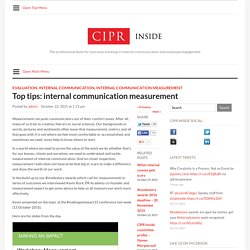
After all, many of us train in creative, literary or social sciences. Why you must measure employee communication—and how to do it. Your average internal communicator is lonesome.
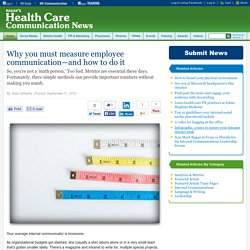
As organizational budgets got slashed, she (usually a she) labors alone or in a very small team that's gotten smaller lately. There's a magazine and intranet to write for, multiple special projects, and internal social media. Measuring Internal Communication. As communicators, we’re faced with the constant tension between art and science.

On the one hand, we’re tasked with developing creative and memorable messages that inspire and motivate employees—creating an emotional connection to their work. At the same time, we’re responsible for proving the value of internal communication—showing measurable evidence that what we’re doing is improving business performance. And let’s face it, for most communicators, the creativity of our work is usually the most appealing of the two. But to truly be effective, we have to be as passionate about measurement as we are about messaging. At the end of the day, organizations want to know that their investment in internal communication is worth the resources—time, money, people, etc. 3 Ways to Measure Employee Communication. Guest Post by Sean Williams Your average internal communicator is lonesome.
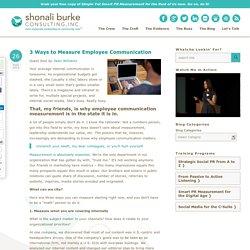
As organizational budgets got slashed, she (usually a she) labors alone or in a very small team that’s gotten smaller lately. There’s a magazine and intranet to write for, multiple special projects, and internal social media. She’s busy. Really busy. A lot of people simply don’t do it. Unclench your teeth, my dear colleagues, or you’ll hurt yourself. The state of internal communication in the U.K. Gatehouse Group recently released its fifth annual State of the Sector report on internal communication.

The report is Gatehouse Group's industry-wide census. It investigates the challenges internal communicators face, and where their focus will be over the coming months. Here are some highlights from this year's report: Employee-focused apps are on the rise. Almost 40 percent of organizations allow employees to access internal content via mobile devices. The survey was conducted in November 2013, and 157 communicators from organizations large and small had their say. How To Measure the Value of Internal Communications [Infographic] All month long, we've been investigating the company intranet. We've defined it, considered its relevancy and secrets for strategic success, as well as examined a possible intranet identity crisis. But how do you measure its value — that is, how do you know if your intranet is working? You could look for statistics that show how much intranet use deems it a successful initiative, but when it comes to tools designed to make businesses work better, smarter and more efficiently, it's often best to incorporate a qualitative component into your research.
Technically, your company's intranet is just another website. Plot your employee social network on the SMILE Matrix. How do you know where your organisation is on its journey towards a collaborative internal social network?
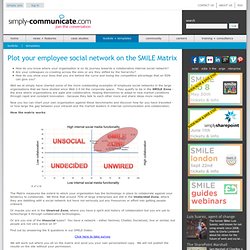
Are your colleagues co-creating across the silos or are they stifled by the hierarchy? How do you show your boss that you are behind the curve and losing the competitive advantage that an ESN can give you? Well we at simply have charted some of the more outstanding examples of employee social networks in the large organisations that we have studied since Web 2.0 hit the corporate space. They qualify to be in the SMILE Zone - the area where organisations are agile and collaborative, helping themselves to adapt to new market conditions through rapid and constant innovation - because they talk to each other more and share ideas more readily. Rockstar Comms - Internal Communication Tips & Tactics for Easygoing Internal Comms. You’re about to read an extract from the Journal of Internal Communication. It’s a 100 page professional journal with real case studies and handy advice. If you’re working in internal communication, you need to be a subscriber. Go and sign up for your subscription now.
Engagement and communication expert Rom Shibi explains the importance of measurement Today, leaders are quantifying and measuring every different aspect of their business. Still, if we’re going to handle IC in a professional manner, we have to measure ourselves. Rockstar Comms - Internal Communication Tips & Tactics for Easygoing Internal Comms. Article. Not all business goals are created equal.
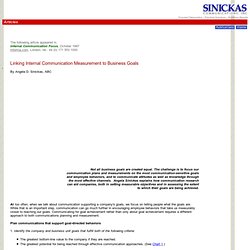
The challenge is to focus our communication plans and measurements on the most communication-sensitive goals and employee behaviors, and to communicate attitudes as well as knowledge through the most effective channels. Angela Sinickas explains how communication research can aid companies, both in setting measurable objectives and in assessing the extent to which their goals are being achieved. All too often, when we talk about communication supporting a company's goals, we focus on telling people what the goals are. While that is an important step, communication can go much further in encouraging employee behaviors that take us measurably closer to reaching our goals. Communicating for goal achievement rather than only about goal achievement requires a different approach to both communications planning and measurement. Plan communications that support goal-directed behaviors. Communication Measurement June 2009. Top measurement headaches for internal communication professionals revealed.
PRLog (Press Release) - Mar. 5, 2012 - Internal communication professionals say the impact of campaigns around corporate objectives, values and change are the toughest to measure, according to results of a new survey by the Institute of Internal Communication.
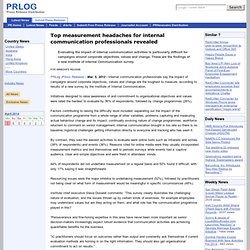
Initiatives designed to raise awareness of and commitment to organisational objectives and values were rated the hardest to evaluate by 36% of respondents, followed by change programmes (26%). Factors contributing to raising the difficulty level included: separating out the impact of the communication programme from a whole range of other variables; problems capturing and measuring actual behaviour change and its impact; continually evolving nature of change programmes; workforce reluctant to comment on senior management; internal communication brought in too late so there is no baseline; logistical challenges getting information directly to everyone and tracking who has seen it. *48 respondents took part in this survey.
Measuring the Effectiveness of Employee Communications. Slide 1 Measuring the Effectiveness of Employee Communications A General Motors Case Study Kathy Collins Director, Communications Research Slide 2.

Measuring Internal Communications. An annual employee survey is a useful communications measurement tool, but is it really enough?
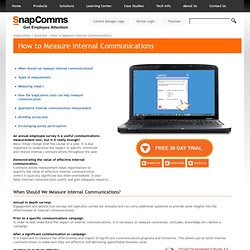
Many things change over the course of a year. EXPLORING INTERNAL COMMUNICATION. I’m not usually a numbers person. But I am fascinated by what numbers can tell you. Seventy per cent of change management projects fail to achieve their objectives – that’s a telling stat. In my own research I recently examined twelve leading academic and consultancy studies representing 10,928 respondents.
What I found is that general employee satisfaction with internal communication ranges from 53 per cent to 64 per cent. Around 60 per cent of employees say they understand where the organisation is headed. Because of the disparity in a lot of existing survey tools, my supervisor at UCLan, Dr. In the meantime, I’m doing some practitioner based research about internal communication with the CIPR Inside group.
Kevin RuckAbout post author.